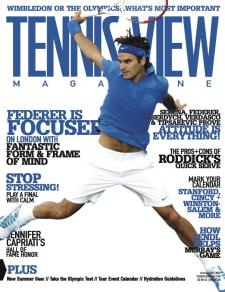Don't miss any stories → Follow Tennis View
FollowAttitude Adjustment – Publisher’s Point

WATCHING NOVAK DJOKOVIC AND RAFAEL NADAL react negatively to the new blue clay at Madrid, and subsequently losing to underdogs, triggered a flashback to one of my recent matches, reinforcing the impact of attitude.
I prepare differently for a singles match than doubles. The day before singles, I drink more water, eat foods with less fat, salt and sugar, reduce my running to shorter distances and try to get a little extra sleep. The more I prepare, the better I feel physically and mentally, which gives me optimum confidence on match day.
CONCERN NO. 1:
Lack of Preparation. Recently, my USTA 4.0 captain assigned me to play singles instead of doubles. Typically, I’d be thrilled with the news, but not being informed until literally minutes before the start of the match caused worry.
CONCERN NO. 2:
0-1 Head-To-Head. When I saw my friendly opponent walking towards me, I knew I was in trouble. I’d smile too, if I were her, as she beat me handily 6-3, 6-2, a year ago in our first encounter.
CONCERN NO. 3:
Undesirable court conditions. We were sentenced to court No. 8, the worst court at the club. Being a home match, I was all too familiar: no shade, no breeze, several holes in the fence, no divider between the adjacent court to prevent balls from rolling and, most concerning of all, the green clay surface was desert dry and slippery.
CONCERN NO. 4:
Lack of focus and belief. During warm-up, my opponent’s unorthodox strokes reminded me of just how difficult it is to play her. I should have been thinking about foot- work and stroke production, but instead, my mind wandered to my aching foot, the hot temperature, how lucky my teammates were to be playing doubles on nicer courts with shade and cold water. “How deep will I have to dig to compete well and, even so, will my best be good enough to beat her?” I asked myself.
ADJUSTMENT NO. 1:
Develop game plan + positive attitude. Reminiscent of our first encounter, she jumped ahead 3-0 in the first set. During changeover, I regrouped, and my desire to perform was motivated by wanting to do better for the team. “Play with more patience and allow for more margin of error. I can’t control the outcome, but I can control my effort,” I convinced myself.
ADJUSTMENT NO. 2:
Pain reliever + bathroom break. We exchanged longer rallies, I played a lot smarter, a little bit harder and with a lot more focus. Before I knew it, good strokes had led to points and games. After 90 minutes, I took the first set in a tiebreaker, a couple of pain relievers for my foot and a bath- room break.
ADJUSTMENT NO. 3:
Be unpredictable –don’t let up. I returned from break to find my opponent practicing serves – I expected her to come out strong in the second. In response, I played more aggressively, looking for opportunities to approach the net. With great anticipation and relentless effort, I chased down every ball.
ADJUSTMENT NO. 4:
Increased focus + confidence. At 5-4, 40-0, I served for the match. She hit a drop shot that I anticipated plenty early, but as I pushed off to sprint, my foot slid on the clay that had been sifted to a powder-like consistency. I fell, and although I wasn’t hurt physically, I recognized the potential mental impact it might have. I toweled off, lost the game and eventually the set. Regardless of the second set outcome, I told myself: “This is my match. I earned it. Go get it.”
I started the third set 10-point tiebreaker with calm focus, commit- ting to give full effort to every stroke. It could have gone either way, but I was fortunate that afternoon. After 3 hours and 10 minutes, our contest ended in my favor, 7-6, 5-7, 10-4.
SUMMARY
I started the match with plenty of excuses as to why I shouldn’t win: lack of preparation, my opponent is better and the court conditions stunk, to name a few. A mental landslide could have occurred, but because I blocked the negative thoughts early in the match I prevailed.
When Nadal lost in the third round of Madrid to Fernando Verdasco and Djokovic in the quarterfinals to Tipsarevic and blamed the clay for their defeat, I raised an eyebrow in surprise and disappointment. Most players admitted that the blue clay was more slippery, yet didn’t complain. Both Djokovic and Nadal took their argument so far as to threaten to boycott the event if officials don’t return to traditional red clay next year.
Athletes at every level face obstacles that threaten success. A big component of Djokovic’s and Nadal’s greatness is their ability to adjust to those obstacles and conquer – or attempt to conquer. Rather than make a huff about court aesthetics, I look for the world’s top ranked players to say, “I’ll need to practice more, work harder and try to improve.” That’s the attitude I expect from the best.
This article is from the July / August 2012 issue |
|

|
SOLD OUT Subscribe now and you'll never miss an issue!
|










